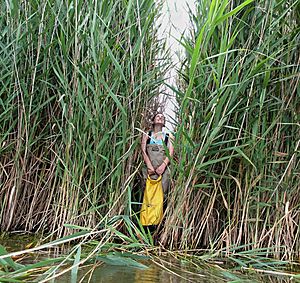Common reed facts for kids
Quick facts for kids Common reed |
|
|---|---|
 |
|
| Conservation status | |
| Scientific classification | |
| Genus: |
Phragmites
|
| Species: |
australis
|
| Synonyms | |
|
Phragmites communis |
|
Phragmites australis, also known as the common reed, is a type of plant. It is a tall grass that grows in wetlands all over the world. This plant can reach heights of up to 20 feet (6 meters).
Contents
What it Looks Like
Common reeds often grow in huge groups called reed beds. These groups can cover an area as large as 1 square kilometer (0.4 square miles). They can spread quickly, growing more than 5 meters (16 feet) per year. They do this using long underground stems called runners. These runners send down roots at regular spots.
This plant can grow in wet ground or in water up to 1 meter (3 feet) deep. It can even form floating mats on the water. The upright stems grow to be 2 to 4 meters (6.5 to 13 feet) tall. The tallest plants are found in places with hot summers and rich soil.
The leaves are 18 to 60 centimeters (7 to 24 inches) long and 1 to 6 centimeters (0.4 to 2.4 inches) wide. In late summer, the plant produces dark purple flowers. These flowers grow in a dense cluster called a panicle, which is about 15 to 40 centimeters (6 to 16 inches) long. Later, the flowers turn gray because of long, silky hairs that grow on them. These hairs help spread the tiny seeds.
Different Types of Common Reed
There are different types of Phragmites australis. In North America, scientists have found differences between the reeds that are native (naturally from there) and those that were brought in from other places.
- Phragmites australis subsp. americanus is the type found naturally in North America.
- Phragmites australis subsp. australis is the type that comes from Europe.
Where it Grows and Lives
The common reed is an aquatic plant that loves wet places. It grows well in areas with alkaline soil. It can also handle salty water, so you often find it near the edges of estuaries (where rivers meet the sea) and other wetlands.
If livestock like cows or sheep eat the common reed regularly, it won't grow as tall. It might stay as small shoots in the grass or disappear completely. In Europe, common reed usually doesn't spread too much. But it can become a problem in wet grasslands if animals stop grazing there.
Why it Can Be a Problem
In North America, the common reed is often seen as an invasive species. This means it's not native to the area and can cause harm. The type from Europe, Phragmites australis subsp. australis, is much stronger and spreads faster than the native North American type.
When the European common reed spreads, it can push out native plants. It lowers the number of different plant types in an area, which is called biodiversity. It forms thick, dense patches that are not good habitat for native animals. It takes the place of plants like wild rice, cattails, and native orchids.
The European common reed grows very tall and thick above the ground. This blocks sunlight from reaching other plants, causing areas to quickly become a Phragmites monoculture (only one type of plant). When Phragmites dies and breaks down, it can make marshes build up land faster than native plants would.
The European common reed is a big problem for many other wetland plants in North America. It releases a chemical called Gallic acid. When this acid is hit by ultraviolet light from the sun, it turns into another harmful chemical called mesoxalic acid. These two toxins can hurt other plants and seedlings.
It is very hard to control Phragmites. One way to get rid of it is to burn it for 2 to 3 years in a row. The roots grow so deep and strong that one burn is not enough. Some research suggests that goats could also help control this plant.
Natural Enemies
Since 2017, a tiny insect called the roseau cane scale (Nipponaclerda biwakoensis) has damaged many Phragmites beds in Louisiana. This insect is also an invasive species. While common reed is often seen as a weed, in Louisiana its reed beds are important. They help keep the shorelines of the Mississippi Delta wetlands stable. When the reed beds die, it can make coastal erosion worse.
How People Use It
The entire common reed plant can be eaten, either raw or cooked. The young stems can be boiled. Older stems can be used to make flour. The underground stems (roots) can also be eaten, but they are tough. The seeds are hard to find but can also be used.
The stems can be made into eco-friendly drinking straws. The hardened sap from damaged stems can be eaten fresh or toasted. The stems can be dried, ground, and mixed with water to be toasted like marshmallows. The seeds can be crushed with berries and water, then cooked to make a porridge. The roots can be prepared like those of cattails.
Common reeds are also a main source of thatch. Thatch is used for making traditional roofs on houses in Europe and other places.
This plant is also used in natural water treatment systems called phytodepuration. Its root hairs are very good at filtering out dirt and impurities from wastewater.
Phragmites australis also shows great promise as a source of biomass. Biomass is plant material that can be used to create energy.
See also
 In Spanish: Carrizo para niños
In Spanish: Carrizo para niños



